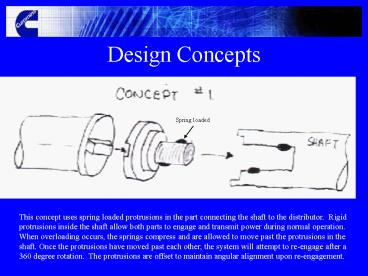Design Concepts - PowerPoint PPT Presentation
1 / 4
Title:
Design Concepts
Description:
Rigid protrusions inside the shaft allow both parts to engage and transmit power ... on the part will try and disengage from holes in the distributor side. ... – PowerPoint PPT presentation
Number of Views:40
Avg rating:3.0/5.0
Title: Design Concepts
1
Design Concepts
Spring loaded
This concept uses spring loaded protrusions in
the part connecting the shaft to the distributor.
Rigid protrusions inside the shaft allow both
parts to engage and transmit power during normal
operation. When overloading occurs, the springs
compress and are allowed to move past the
protrusions in the shaft. Once the protrusions
have moved past each other, the system will
attempt to re-engage after a 360 degree rotation.
The protrusions are offset to maintain angular
alignment upon re-engagement.
2
Design Concepts
Concept 2
This concept uses one spring, located in a hole
drilled into the shaft. This concept operates on
relatively the same principle as concept 1. The
spring provides pressure on the part between the
shaft and the distributor. When overloading
occurs, protrusions on the part will try and
disengage from holes in the distributor side.
The protrusions will be designed so that the
parts can only align in one configuration to
maintain angular alignment.
3
Design Concepts
Concept 3
This concept uses one spring loaded ball in one
of two parts connecting the shaft to the
distributor. Another rigid protrusion on the
second part allows the parts to engage and
transmit power during normal operation. When
overloading occurs, the spring compresses and the
ball is allowed to move past the protrusion. The
system will attempt to re-engage after a 360
degree rotation.
4
Design Concepts
Concept 4
This concept uses two small disks that are
allowed to pivot. One disk is connected to the
shaft, while the other is connected to a part
between the distributor and shaft. A spring
applies pressure to one of the disks, maintaining
both disks at an angle. While at an angle the
disks will be able to transmit power. When
overloading occurs, the disk on the distributor
side will stop. The other disk will want to keep
turning and will therefore compress the spring
and position the disks in a vertical
configuration. Once in a vertical configuration
the disk attached to the shaft will continue to
turn.(The disk surfaces will be machined smooth
to provide minimal friction.) The pivot points
of the disks are offset to allow the system to
only re-engage in one position after 360 degrees.































